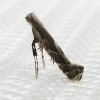 Leucospilapteryx venustella (Clemens) (Lepidoptera: Gracillariidae) is a small, mostly light brown moth that during its larval stages creates mines in the leaves of plants in the family Asteraceae. Feeding damage by the early instars is characterized by serpentine mines that are expanded by later instars to form tentiform or blotch mines. This 4-page fact sheet was written by Rodrigo Diaz, Esteban Tapia, Veronica Manrique, William Overholt, and Donald Davis, and published by the UF Department of Entomology and Nematology, February 2014.
Leucospilapteryx venustella (Clemens) (Lepidoptera: Gracillariidae) is a small, mostly light brown moth that during its larval stages creates mines in the leaves of plants in the family Asteraceae. Feeding damage by the early instars is characterized by serpentine mines that are expanded by later instars to form tentiform or blotch mines. This 4-page fact sheet was written by Rodrigo Diaz, Esteban Tapia, Veronica Manrique, William Overholt, and Donald Davis, and published by the UF Department of Entomology and Nematology, February 2014.
http://edis.ifas.ufl.edu/in1029
Tag: Rodrigo Diaz
Scarlet-bodied wasp moth, Cosmosoma myrodora (Dyar) (Insecta: Lepidoptera: Arctiidae)
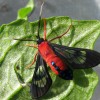 The scarlet-bodied wasp moth, Cosmosoma myrodora (Dyar), is a beautiful native insect. Because of its striking adult coloration, including a bright red thorax and abdomen, and transparent wings patterned with black, this moth immediately stands out in Florida landscapes. Larval feeding is restricted to two native plants in the genus Mikania, family Asteraceae. This 5-page fact sheet was written by Diego Moscoso, Rodrigo Diaz, and William A. Overholt, and published by the UF Department of Entomology and Nematology, May 2013.
The scarlet-bodied wasp moth, Cosmosoma myrodora (Dyar), is a beautiful native insect. Because of its striking adult coloration, including a bright red thorax and abdomen, and transparent wings patterned with black, this moth immediately stands out in Florida landscapes. Larval feeding is restricted to two native plants in the genus Mikania, family Asteraceae. This 5-page fact sheet was written by Diego Moscoso, Rodrigo Diaz, and William A. Overholt, and published by the UF Department of Entomology and Nematology, May 2013.
http://edis.ifas.ufl.edu/in996
Uso Apropiado y Manipulacion de Glifosato en Viveros de Plantas (ENH1209/EP470)
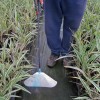 El glifosato es el químico de protección para cultivos más vendido en el mundo y el herbicida mós usado en la industria de viveros de plantas en los Estados Unidos. El glifosato es usado para el control post emergente de malezas. Esta publicación describe el uso adecuado de glifosato para los productores de plantas y sus empleados. This 4-page fact sheet was written by Shawn T. Steed, Robert H. Stamps, and Rodrigo Diaz, and published by the UF Department of Environmental Horticulture, February 2013.
El glifosato es el químico de protección para cultivos más vendido en el mundo y el herbicida mós usado en la industria de viveros de plantas en los Estados Unidos. El glifosato es usado para el control post emergente de malezas. Esta publicación describe el uso adecuado de glifosato para los productores de plantas y sus empleados. This 4-page fact sheet was written by Shawn T. Steed, Robert H. Stamps, and Rodrigo Diaz, and published by the UF Department of Environmental Horticulture, February 2013.
http://edis.ifas.ufl.edu/ep470
Tropical Soda Apple Leaf Beetle, Gratiana boliviana Spaeth (Insecta: Coleoptera: Chrysomelidae: Cassidinae) (EENY543/IN974)
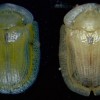 Tropical soda apple is a prickly shrub native to South America that is a major problem in pastures and conservation areas. So a multi-agency program supported the rearing, distribution, and release of more than 250,000 tropical soda apple leaf beetles across Florida from 2003 to 2011. This 4-page fact sheet was written by Rodrigo Diaz, William A. Overholt, Ken Hibbard, and Julio Medal, and published by the UF Department of Entomology and Nematology, January 2013.
Tropical soda apple is a prickly shrub native to South America that is a major problem in pastures and conservation areas. So a multi-agency program supported the rearing, distribution, and release of more than 250,000 tropical soda apple leaf beetles across Florida from 2003 to 2011. This 4-page fact sheet was written by Rodrigo Diaz, William A. Overholt, Ken Hibbard, and Julio Medal, and published by the UF Department of Entomology and Nematology, January 2013.
http://edis.ifas.ufl.edu/in974
Classical Biological Control of Tropical Soda Apple with Gratiana boliviana (ENY865/IN971)
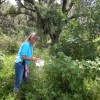 Tropical soda apple is a prickly shrub native to South America. First reported in Glades Co., Florida in 1988, it later spread to Georgia, Alabama, Louisiana, Texas, Mississippi, Tennessee, North Carolina, and South Carolina. It is a major problem in pastures and conservation areas. Negative impacts of tropical soda apple include reduction of cattle stocking rates, competition with native plants, and the costs associated with its control. Dense thickets of the weed also can disrupt the movement of wildlife. This 4-page fact sheet provides a summary of the major steps of the successful biological control program against tropical soda apple in Florida. The article covers the importance of the weed, identification and biology of the biological control agent, rearing and release efforts, establishment and impact, and efforts to communicate the outcomes of the program to stakeholders. Written by R. Diaz, J. Medal, K. Hibbard, A. Roda, A. Fox, S. Hight, P. Stansly, B. Sellers, J. Cuda and W. A. Overholt, and published by the UF Department of Entomology and Nematology, November 2012.
Tropical soda apple is a prickly shrub native to South America. First reported in Glades Co., Florida in 1988, it later spread to Georgia, Alabama, Louisiana, Texas, Mississippi, Tennessee, North Carolina, and South Carolina. It is a major problem in pastures and conservation areas. Negative impacts of tropical soda apple include reduction of cattle stocking rates, competition with native plants, and the costs associated with its control. Dense thickets of the weed also can disrupt the movement of wildlife. This 4-page fact sheet provides a summary of the major steps of the successful biological control program against tropical soda apple in Florida. The article covers the importance of the weed, identification and biology of the biological control agent, rearing and release efforts, establishment and impact, and efforts to communicate the outcomes of the program to stakeholders. Written by R. Diaz, J. Medal, K. Hibbard, A. Roda, A. Fox, S. Hight, P. Stansly, B. Sellers, J. Cuda and W. A. Overholt, and published by the UF Department of Entomology and Nematology, November 2012.
http://edis.ifas.ufl.edu/in971
Phragmites in Florida (ENY860/IN898)
 Phragmites are a tall, perennial, wetland grasses, occurring in both fresh and brackish waters. This 3-page fact sheet discusses the three genetic lineages, native, Gulf Coast, and Eurasian; and the threat posed to Florida ecosystems by an invasion of the exotic Eurasian type. Written by W. A. Overholt, R. Diaz, M. Hanson and D. Williams, and published by the UF Department of Entomology and Nematology, December 2011.
Phragmites are a tall, perennial, wetland grasses, occurring in both fresh and brackish waters. This 3-page fact sheet discusses the three genetic lineages, native, Gulf Coast, and Eurasian; and the threat posed to Florida ecosystems by an invasion of the exotic Eurasian type. Written by W. A. Overholt, R. Diaz, M. Hanson and D. Williams, and published by the UF Department of Entomology and Nematology, December 2011.
http://edis.ifas.ufl.edu/in898
EENY471/IN842 Myakka bug, Ischnodemus variegatus (Signoret) (Insecta: Hemiptera:
EENY471, a 6-page illustrated fact sheet by Cecil O. Montemayor, Rodrigo Diaz, William A. Overholt and Amanda Hodges, is part of the Featured Creatures collection. It describes this newly introduced exotic insect species hosted by the invasive West Indian marsh grass, Hymenachne amplexicaulis — synonymy, description, life cycle and biology, damage, economic importance, and natural enemies. Includes references. Published by the UF Department of Entomology and Nematology, February 2010.
http://edis.ifas.ufl.edu/in842